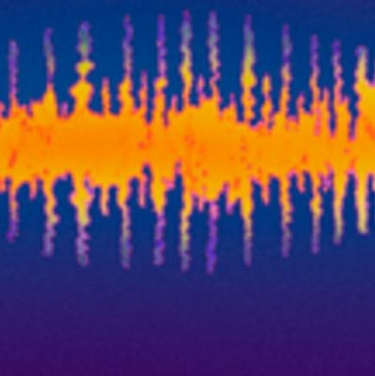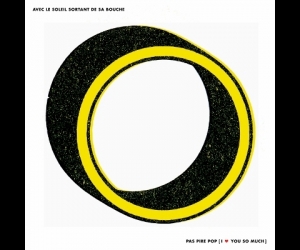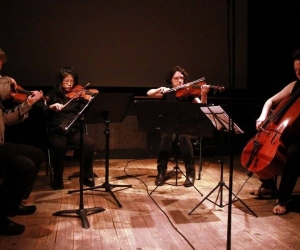
Sound Symposium XV offered up in equal portions traditional concerts, sound installations, urban music, and everything in between. The festival itself became a nine-day art event, greater than the sum of its parts, and for that, the curatorial team deserves to be applauded. For the duration of the festival, the whole city became an auditorium, and its citizens became—sometimes unknowingly—the audience. The curation embraced risk, a prerequisite for a relevant contemporary art festival. With risk comes glorious success. With risk comes failure. And there were plenty of both throughout the festival.
Eve Egoyan and David Rokeby’s multimedia work Surface Tension was a memorable highlight. Egoyan performed on a six-foot disklavier piano that was hooked up via MIDI to Rokeby’s computer, which ran original software, projecting a large dynamic image above the pianist. The work was structured in five improvisatory movements defined by distinct video interactions. The MIDI data coming from the disklavier, including pitch, dynamics, note length, and sustain pedal, affected the image in interesting and novel ways, seamlessly extending Egoyan’s luscious improvising into the world of images. Surface Tension was an effective demonstration of the creative potential of interactive media. Image, initially influenced by music, in turn influenced music. It was a full-circle musical-visual experience that managed to avoid the main danger with this type of project: the never far off thought that you might be watching a screen saver.
German composer and pianist Moritz Eggert played a memorable and high-energy set of his own compositions. Rarely does one encounter a performer so deeply talented and entertaining. His eccentric banter from the stage was as pleasurable as his music, and I found myself wondering if there was any separation at all between his personality and his music. He performed a ‘piano piece’ composed entirely of vocalizations and a piece from his Hämmerklavier cycle—nothing says hard-core new music like bum clusters.
Another virtue of the Sound Symposium curation is the presentation of both emerging and established talent. The group River Connected—two emerging percussionists, Dan Morphy from Toronto and Ed Squires from Newfoundland—presented a meticulously performed set of pieces written by composers from Newfoundland. The compositions were uneven in their quality, but the committed performance of Morphy and Squires made this an engaging program. Newfoundland-born violinist Mark Fewer and percussionist Aiyun Huang delivered a virtuoso performance of insanely difficult new music, including pieces by Aphergis, Harman, and a première of a recently discovered violin solo by Antheil, of Ballet Mechanique fame.
The most engaging installation of the festival was Diane Landry’s Le chevalier de la résignation infinie. It ran for the duration of the festival in the Memorial University band room, close to Cook hall. Provocative and mesmerizing, the piece filled the darkened room with turning wheels, appearing much like windmills. They turned at a slow and steady pace, driven by electric motors. The “spokes” of the wheels were made out of used plastic water bottles, filled with a small amount of sand. As the bottles slowly turned, the sand would dramatically pass a tipping point where it would suddenly spill from the bottom of the bottle to the lid, where a small LED light would be temporarily blocked out. As the circular turn continued, the sand would again move to the other side of the bottle, letting light through again. This constant moving of sand in plastic made a subtle and beautiful sound, like shimmering white noise. So many provocative issues orbit this piece: water, pollution, renewal, perception of time. This piece had great depth.
Other installations included Annie Dunning’s Air Time at the Eastern Edge Gallery and Frank Pahl’s Automatics at the A1C Gallery. Air Time featured artifacts (photos, video, recorded sound) from a collaboration with pigeons, where the artist fitted pigeons with whistles and cameras. Automatics is an exhibit of primitive and grungy-looking automated instruments, where a passer-by could push old-school-looking buttons and controllers to initiate a blast of automated sound.
The harbour symphonies—a perennial favourite at the Sound Symposium, turned the city into a performative space, and the city’s inhabitants into the audience. Every day at12:30 p.m. the festival featured a piece written for ship horns by a different composer involved in the festival. I experienced the harbour symphonies from several different points, including the Queen’s Battery, atop Cabot Tower on signal hill, on the working docks of the harbour, and from a restaurant on Water Street. It was interesting to watch the reaction of people. Some were clearly there for the music, arriving just before 12:30 to, be sure of a good listening position. Some people took no notice at all. Some were surprised and subsequently became inquisitive. The horns sound dramatically different in terms of their timbre, reverberation, and relative position to the listener. Equally informing was the surrounding background sounds. Cabot tower featured constant wind and chattering tourists. On Water Street the ship’s horns were accompanied by street sounds. Interestingly, these factors became defining attributes of the harbour symphony experience, superseding the features of the composition as defined in the scores.
The harbour symphony is an exercise in urban music-making which raises many interesting questions: What is a concert? What is a concert hall? What is music? What is noise? What does it mean to listen? These miniature musical moments bind the whole festival together, and preserve a defining tradition of the Sound Symposium. Bravo to all involved.

